Compact Wearable Meta Materials Antennas for Energy Harvesting Systems, Medical and IOT Systems
Abstract
:1. Introduction
2. Energy Harvesting Systems
3. Wearable Antenna with SRR and Metallic Strips
4. Metamaterial Antennas in Vicinity to the Patient Body
5. Wearable Harvesting System
6. Active Metamaterial Receiving Wearable Antenna
7. Conclusions
Funding
Conflicts of Interest
References
- Sabban, A. Novel Wearable Antennas for Communication and Medical Systems; Taylor & Francis Group: London, UK, October 2017. [Google Scholar]
- Sabban, A. Wideband RF Technologies and Antenna in Microwave Frequencies; Wiley Sons: Hoboken, NJ, USA, July 2016. [Google Scholar]
- Sabban, A. Low Visibility Antennas for Communication System; Taylor & Francis Group: Boca Raton, FL, USA, 2015. [Google Scholar]
- Sabban, A. Microstrip Antenna Arrays. In Microstrip Antennas; InTechOpen: London, UK, 2011; pp. 361–384. ISBN 978-953-307-247-0. [Google Scholar]
- Sabban, A. New wideband printed antennas for medical applications. IEEE J. Trans. Antennas Propag. 2013, 61, 84–91. [Google Scholar] [CrossRef]
- Pendry, J.B.; Holden, A.J.; Stewart, W.J.; Youngs, I. Extremely low frequency plasmons in metallic mesostructures. Phys. Rev. Lett. 1996, 76, 4773–4776. [Google Scholar] [CrossRef] [PubMed]
- Pendry, J.B.; Holden, A.J.; Robbins, D.J.; Stewart, W.J. Magnetism from conductors and enhanced nonlinear phenomena. IEEE Trans. MTT 1999, 47, 2075–2084. [Google Scholar] [CrossRef]
- Marque’s, R.; Mesa, F.; Martel, J.; Medina, F. Comparative analysis of edge and broadside coupled split ring resonators for metamaterial design. Theory and experiment. IEEE Trans. Antennas Propag. 2003, 51, 2572–2581. [Google Scholar] [CrossRef]
- Marque’s, R.; Baena, J.D.; Martel, J.; Medina, F.; Falcone, F.; Sorolla, M.; Martín, F. Novel small resonant waveguides electromagnetic particles for metamaterial and filter design. Phys. Rev. Lett. 2003, 89, 439–442. [Google Scholar]
- Marque’s, R.; Martel, J.; Mesa, F.; Medina, F. Left-handed-media simulation and transmission of EM waves in sub wavelength split-ring-resonator loaded metallic waveguides. Phys. Rev. Lett. 2002, 89, 183901. [Google Scholar] [CrossRef] [PubMed]
- Rajab, K.-Z.; Mittra, R.; Lanagant, M.T. Size reduction of microstrip antennas using metamaterials. In Proceedings of the 2005 IEEE APS Symposium, Washington, DC, USA, 3–8 July 2005. [Google Scholar]
- Jiang, Z.; Eleftheriades, G.V. A Compact Transmission line metamaterial antenna with Extended Bandwidth. IEEE Antennas Wirel. Propag. Lett. 2009, 8, 295–298. [Google Scholar] [CrossRef]
- Baena, J.N.; Marque’s, R.; Martel, J.; Medina, F. Experimental results On Metamaterial simulation using SRR-loaded waveguides. In Proceedings of the IEEE-AP/S International Symposium on Antennas and Propagation, Columbus, OH, USA, 22–27 June 2003; pp. 106–109. [Google Scholar]
- Marque’s, R.; Martel, J.; Mesa, F.; Medina, F. A new 2-D isotropic left-handed Metamaterial design: Theory and experiment, Microwave Opt. Tech. Lett. 2002, 35, 405–408. [Google Scholar]
- Shelby, R.A.; Smith, D.R.; Nemat-Nasser, S.C.; Schultz, S. Microwave transmission through a two-dimensional, left-handed meta- material. Appl. Phys. Lett. 2001, 78, 489–491. [Google Scholar] [CrossRef]
- Chirwa, L.C.; Hammond, P.A.; Roy, S.; Cumming, D.R.S. Electromagnetic Radiation from Ingested Sources in the Human Intestine between 150 MHz and 1.2 GHz. IEEE Trans. Biomed. Eng. 2003, 50, 484–492. [Google Scholar] [CrossRef] [PubMed]
- Werber, D.; Schwentner, A.; Biebl, E.M. Investigation of RF transmission properties of human tissues. Adv. Radio Sci. 2006, 4, 357–360. [Google Scholar] [CrossRef]
- Gupta, B.; Sankaralingam, S.; Dhar, S. Development of wearable and implantable antennas in the last decade. In Proceedings of the 2010 Mediterranean Microwave Symposium (MMS), Guzelyurt, Cyprus, 25–27 August 2010; pp. 251–267. [Google Scholar]
- Thalmann, T.; Popovic, Z.; Notaros, B.M.; Mosig, J.R. Investigation and design of a multi-band wearable antenna. In Proceedings of the 3rd European Conference on Antennas and Propagation, Berlin, Germany, 23–27 March 2009; pp. 462–465. [Google Scholar]
- Salonen, P.; Rahmat-Samii, Y.; Kivikoski, M. Wearable antennas in the vicinity of human body. IEEE Antennas Propag. Symp. 2004, 1, 467–470. [Google Scholar]
- Sabban, A. Wideband printed antennas for medical applications. In Proceedings of the APMC Conference, Singapore, 7–10 December 2009. [Google Scholar]
- Alomainy, A.; Sani, A.; Rahman, A.; Santas, J.-G.; Hao, Y. Transient characteristics of Wearable antennas and Radio propagation channels for ultra- wideband body wireless communication. IEEE Trans. Antennas Propag. 2009, 57, 875–884. [Google Scholar] [CrossRef]
- Klemm, M.; Troester, G. Textile UWB antenna for wireless body area networks. IEEE Trans. Antennas Propag. 2006, 54, 3192–3197. [Google Scholar] [CrossRef]
- Izdebski, P.M.; Rajagoplan, H.; Rahmat-Samii, Y. Conformal ingestible capsule antenna: A novel chandelier meandered design. IEEE Trans. Antennas Propag. 2009, 57, 900–909. [Google Scholar] [CrossRef]
- Sabban, A. Wideband tunable printed antennas for medical applications. In Proceedings of the IEEE Antenna and Propagation Symposium, Chicago, IL, USA, 8–14 July 2012. [Google Scholar]
- James, J.R.; Hall, P.S.; Wood, C. Microstrip Antenna Theory and Design; IET: London, UK, 1981. [Google Scholar]
- Sabban, A. A new wideband stacked microstrip antenna. In Proceedings of the IEEE Antenna and Propagation Symposium, Houston, TX, USA, 23–26 May 1983. [Google Scholar]
- Paradiso, J.A.; Starner, T. Energy scavenging for mobile and wireless electronics. IEEE Pervasive Comput. 2005, 4, 18–27. [Google Scholar] [CrossRef]
- Valenta, C.R.; Durgin, G.D. Harvesting wireless power: Survey of energy-harvester conversion efficiency in far-field, wireless power transfer systems. IEEE Microw. Mag. 2014, 15, 108–120. [Google Scholar]
- Nintanavongsa, P.; Muncuk, U.; Lewis, D.R.; Chowdhury, K.R. Design optimization and implementation for RF energy harvesting circuits. IEEE J. Emerg. Sel. Top. Circuits Syst. 2012, 1, 24–33. [Google Scholar] [CrossRef]
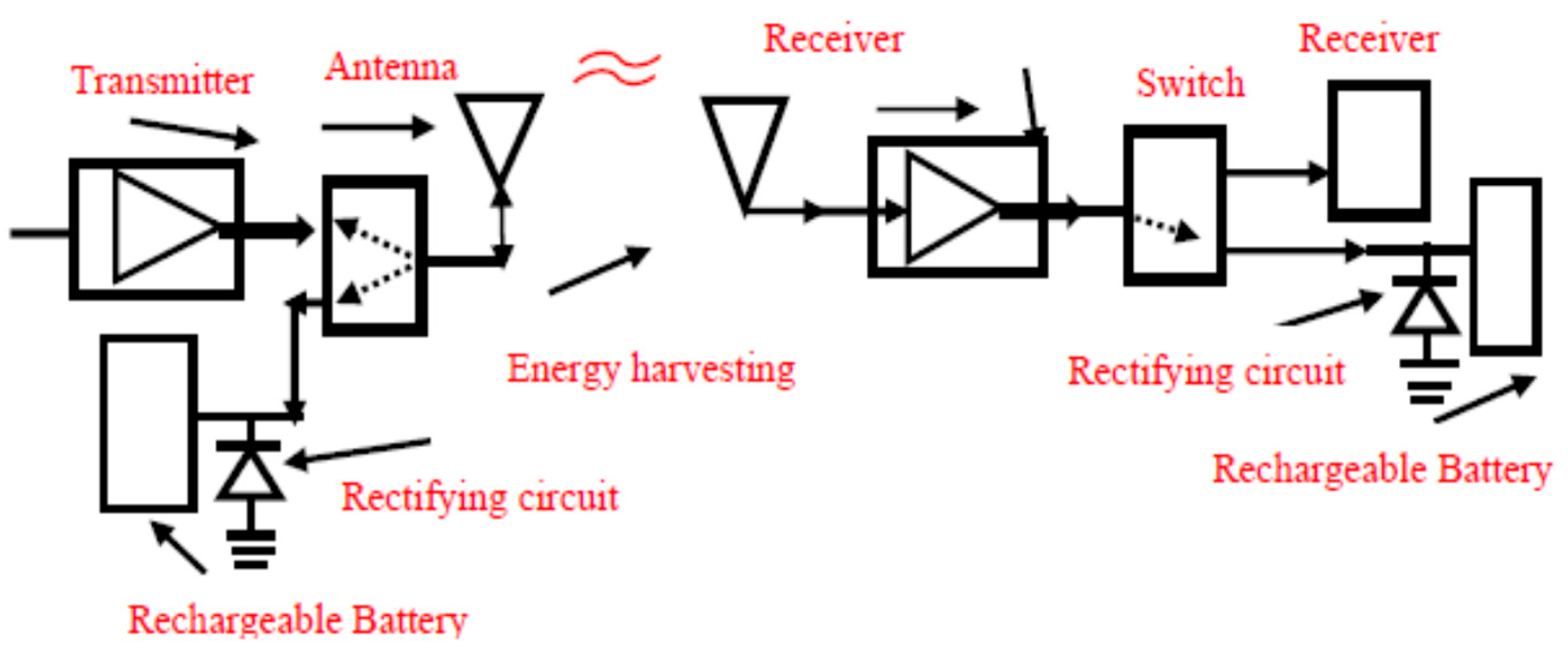




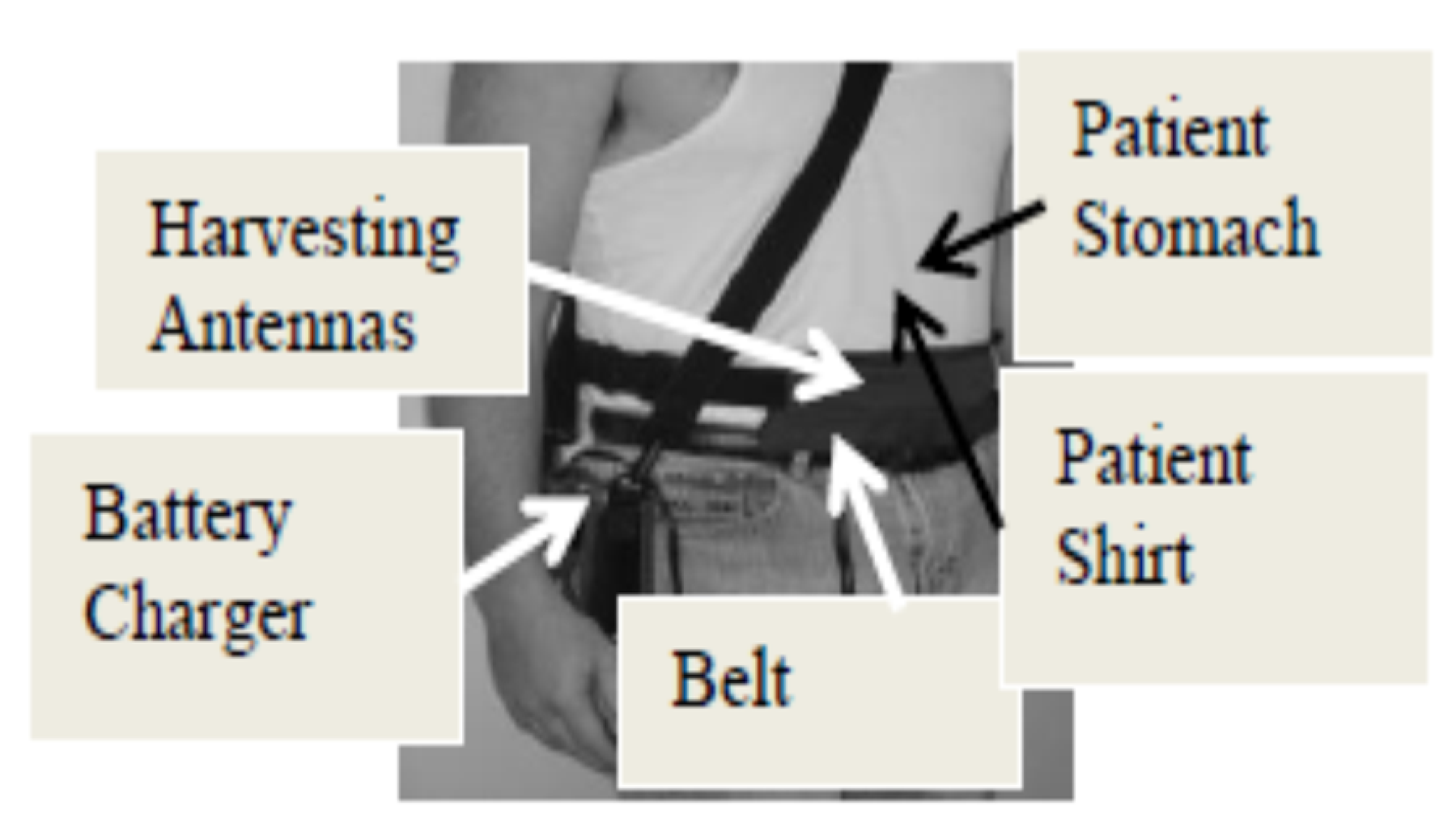
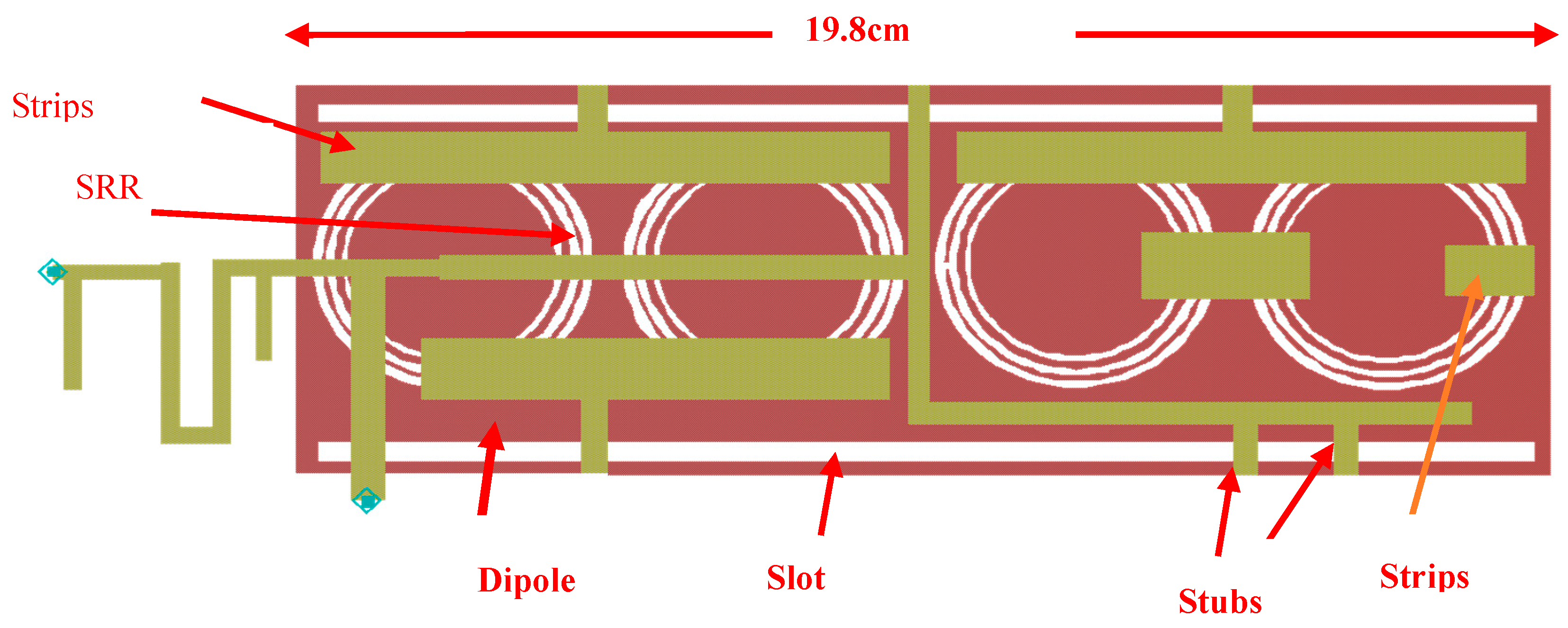
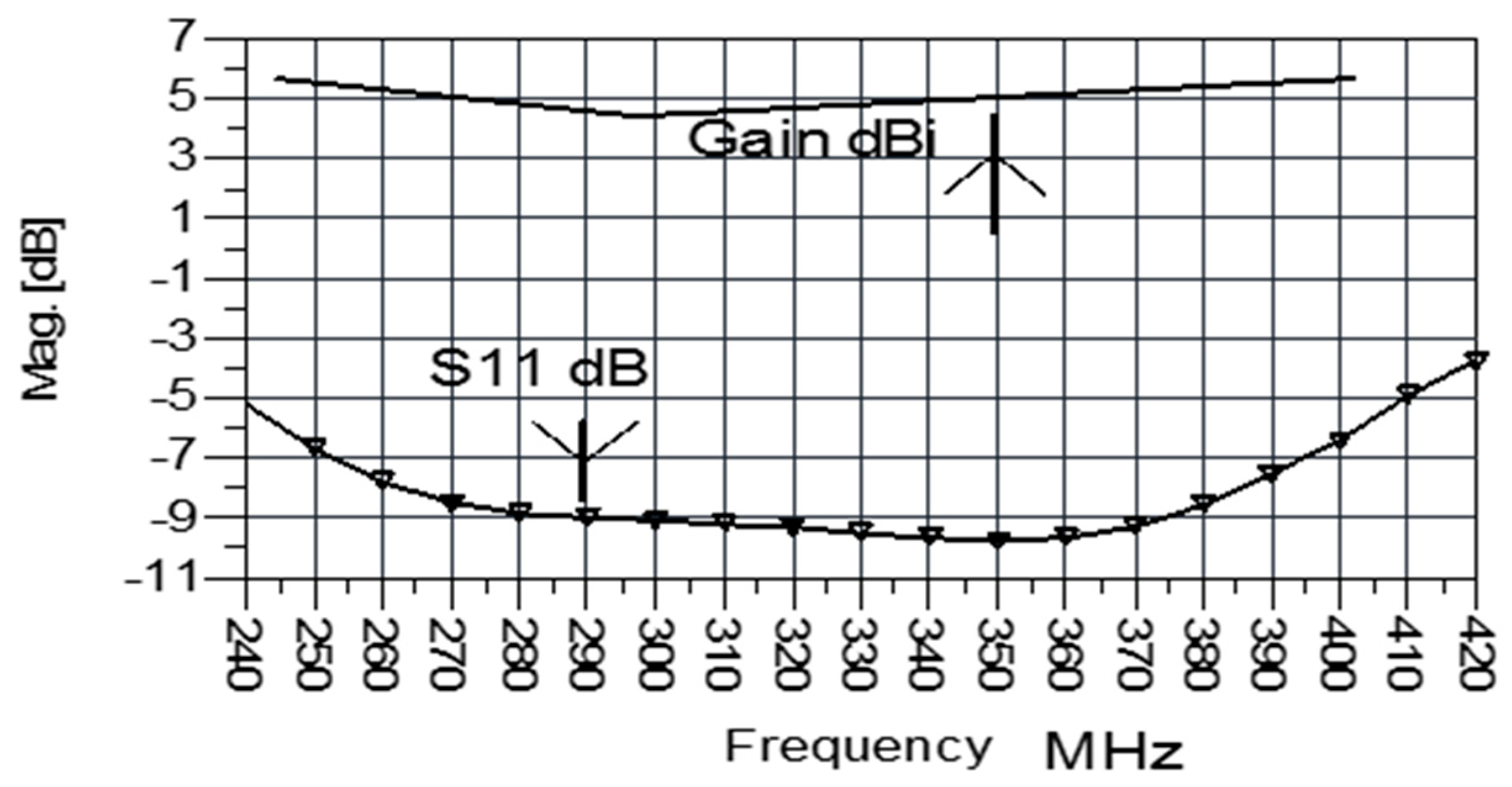
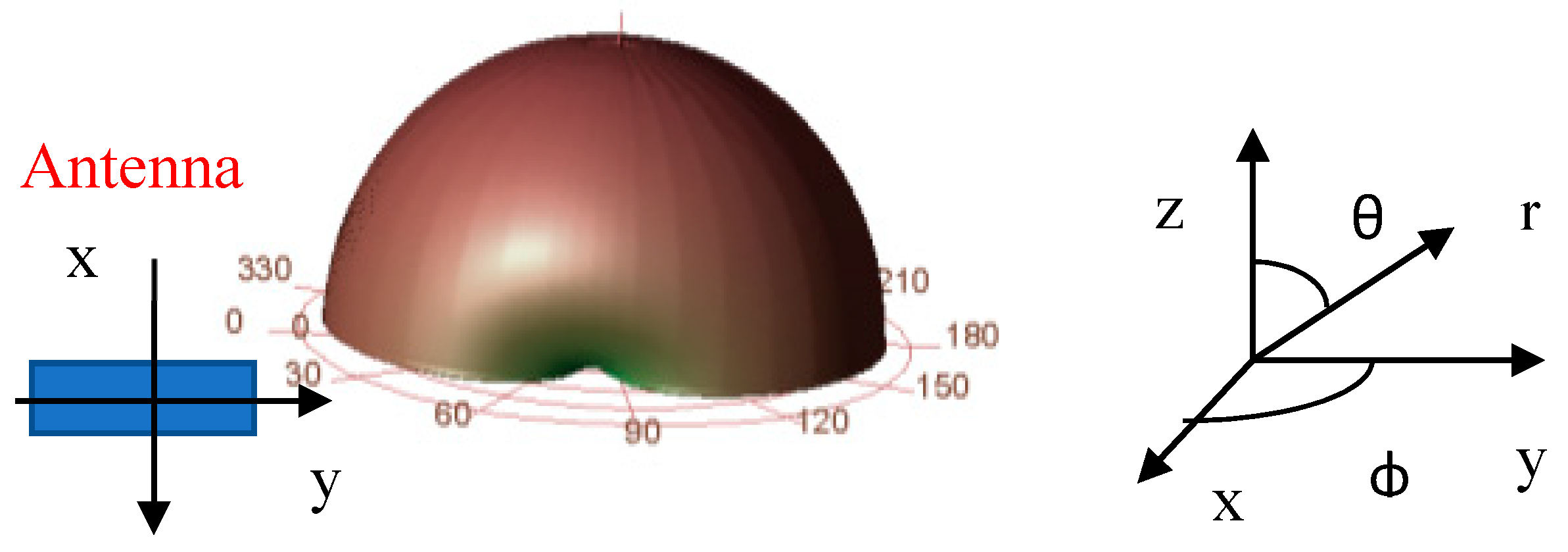
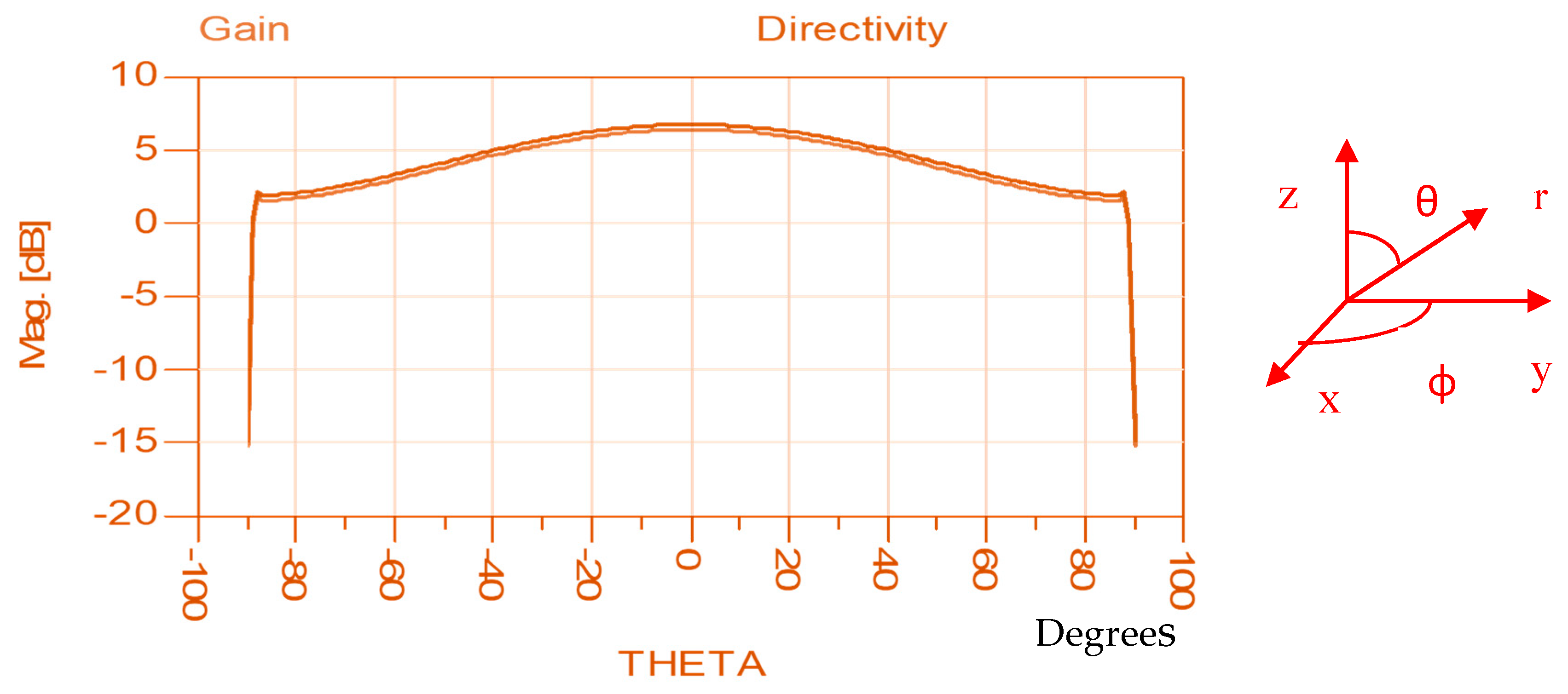
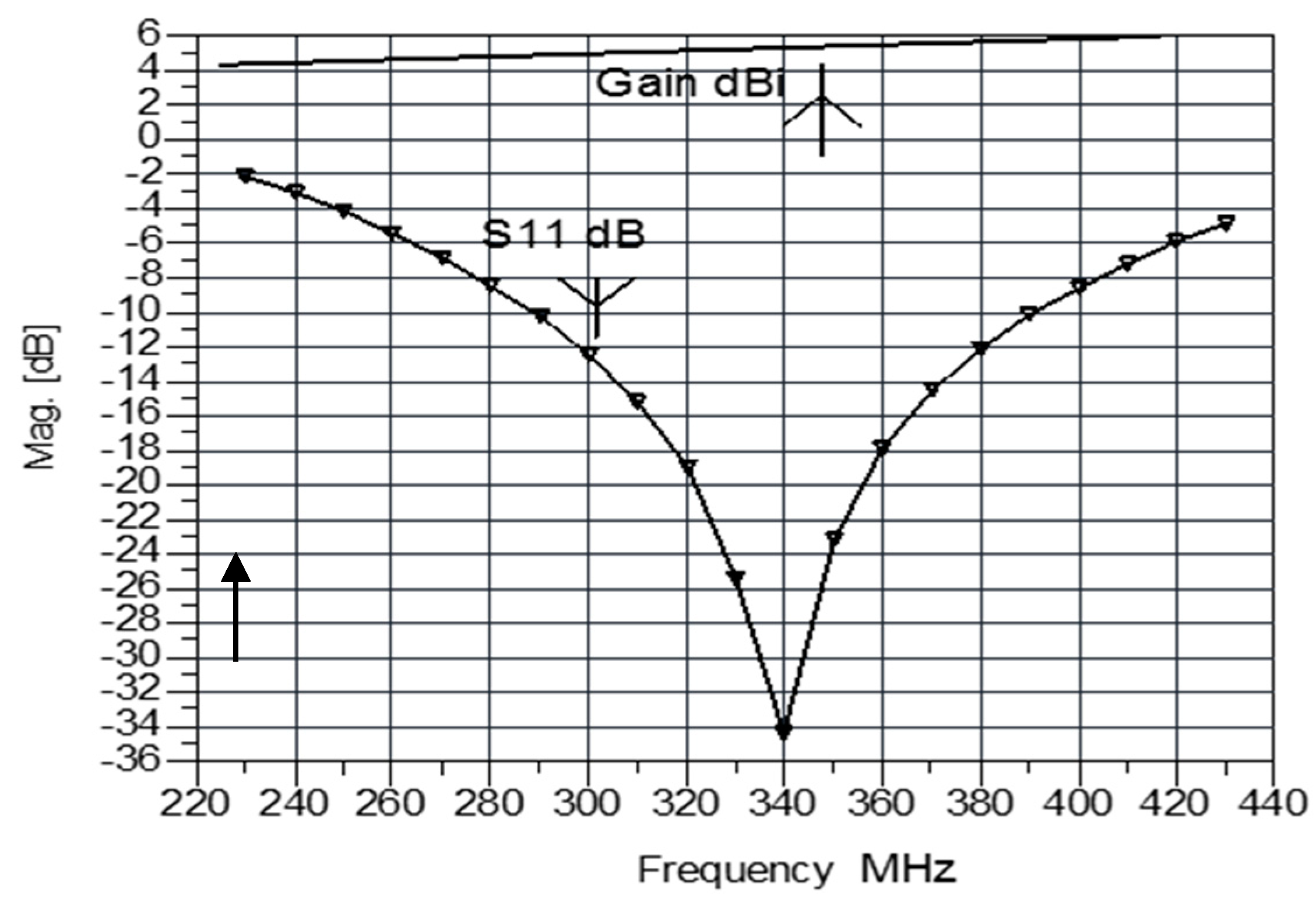
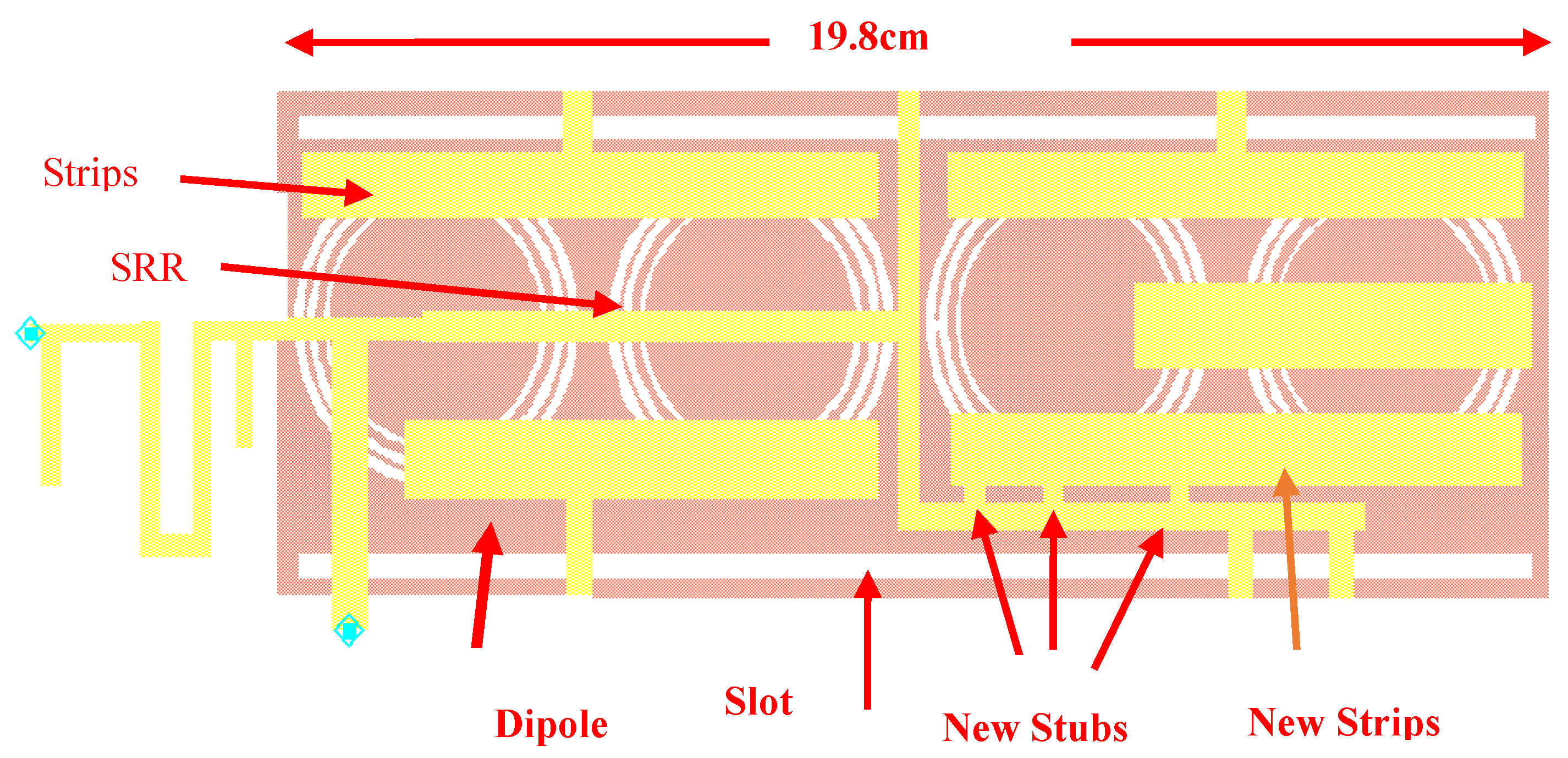
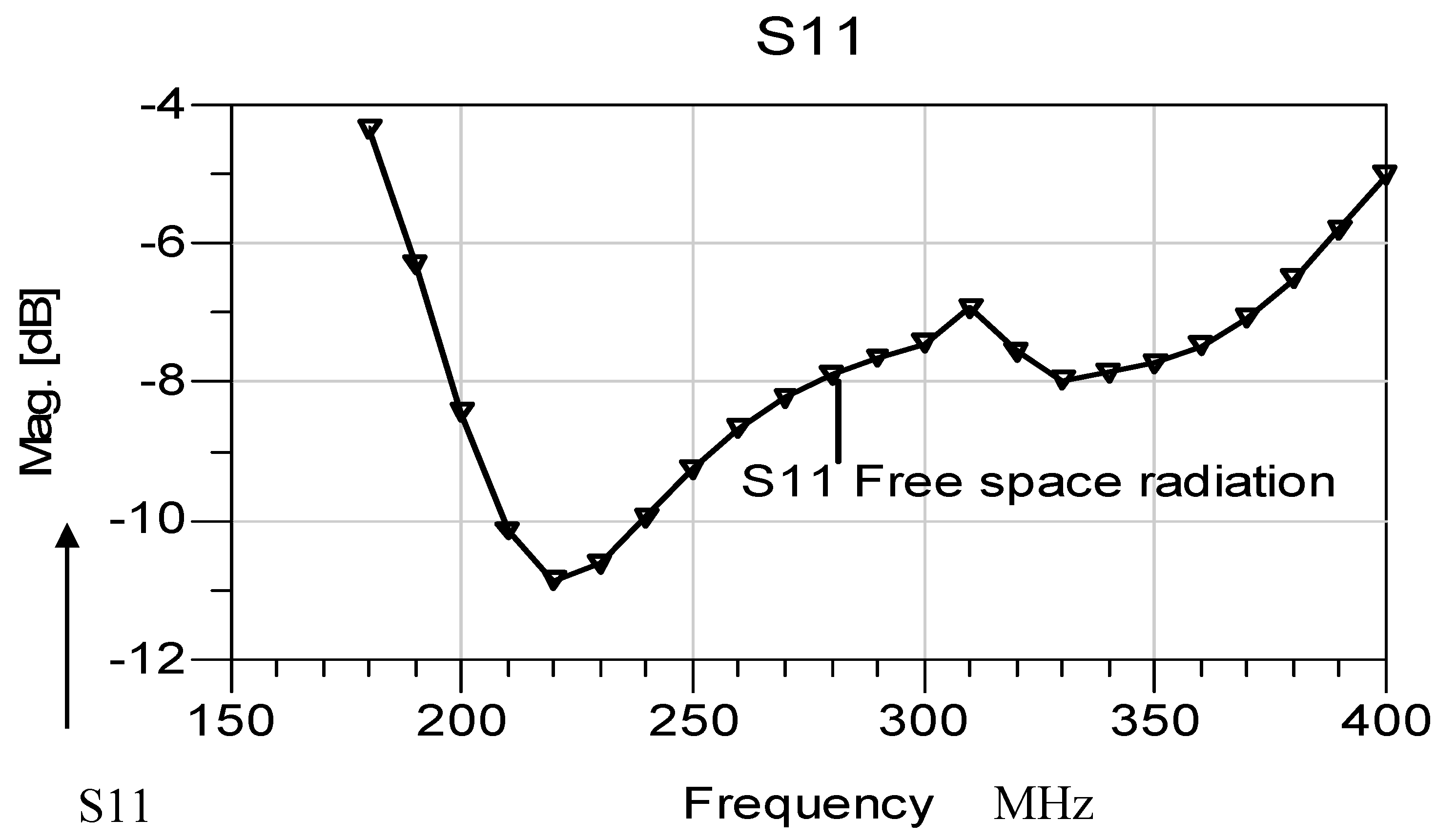
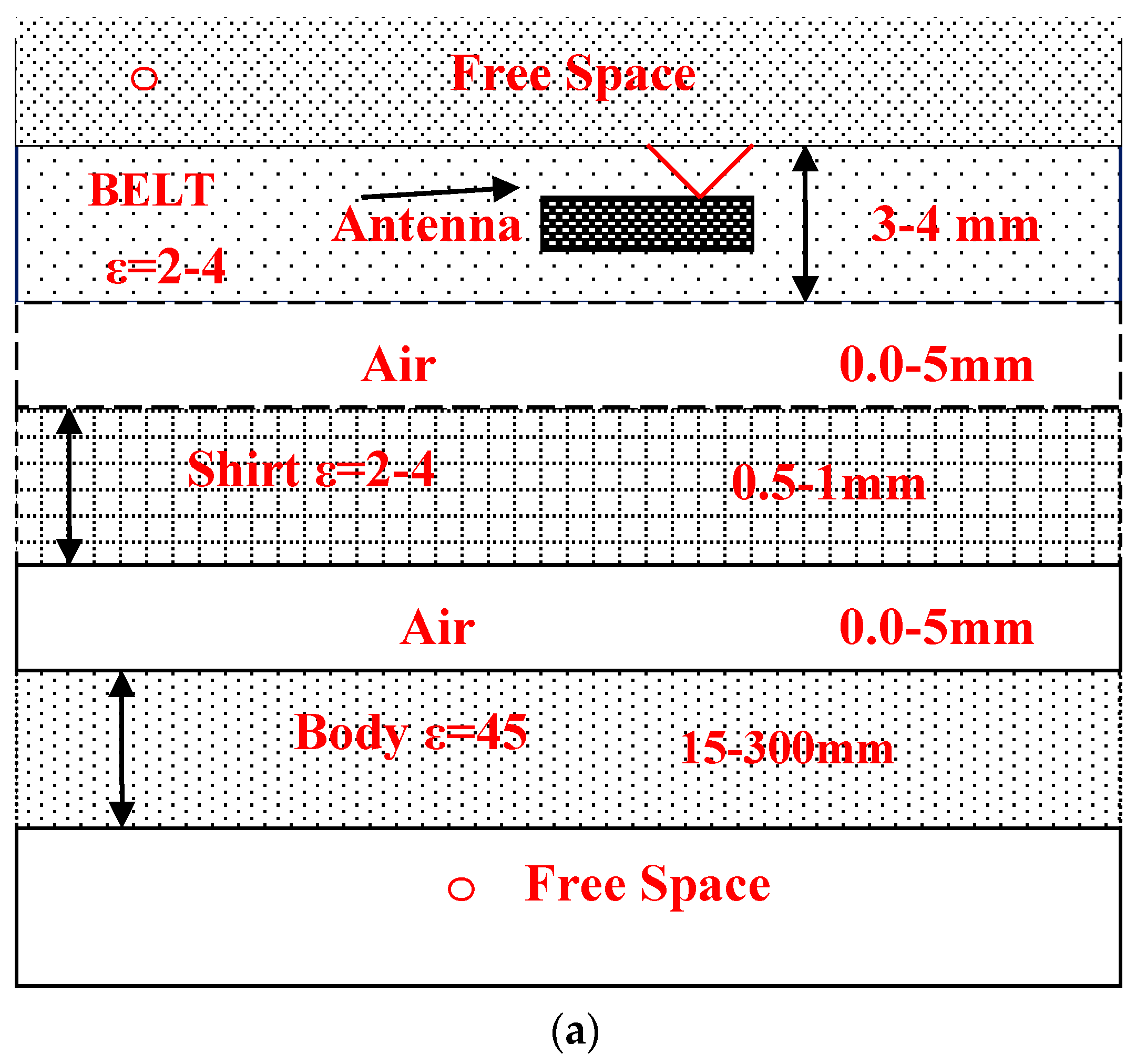
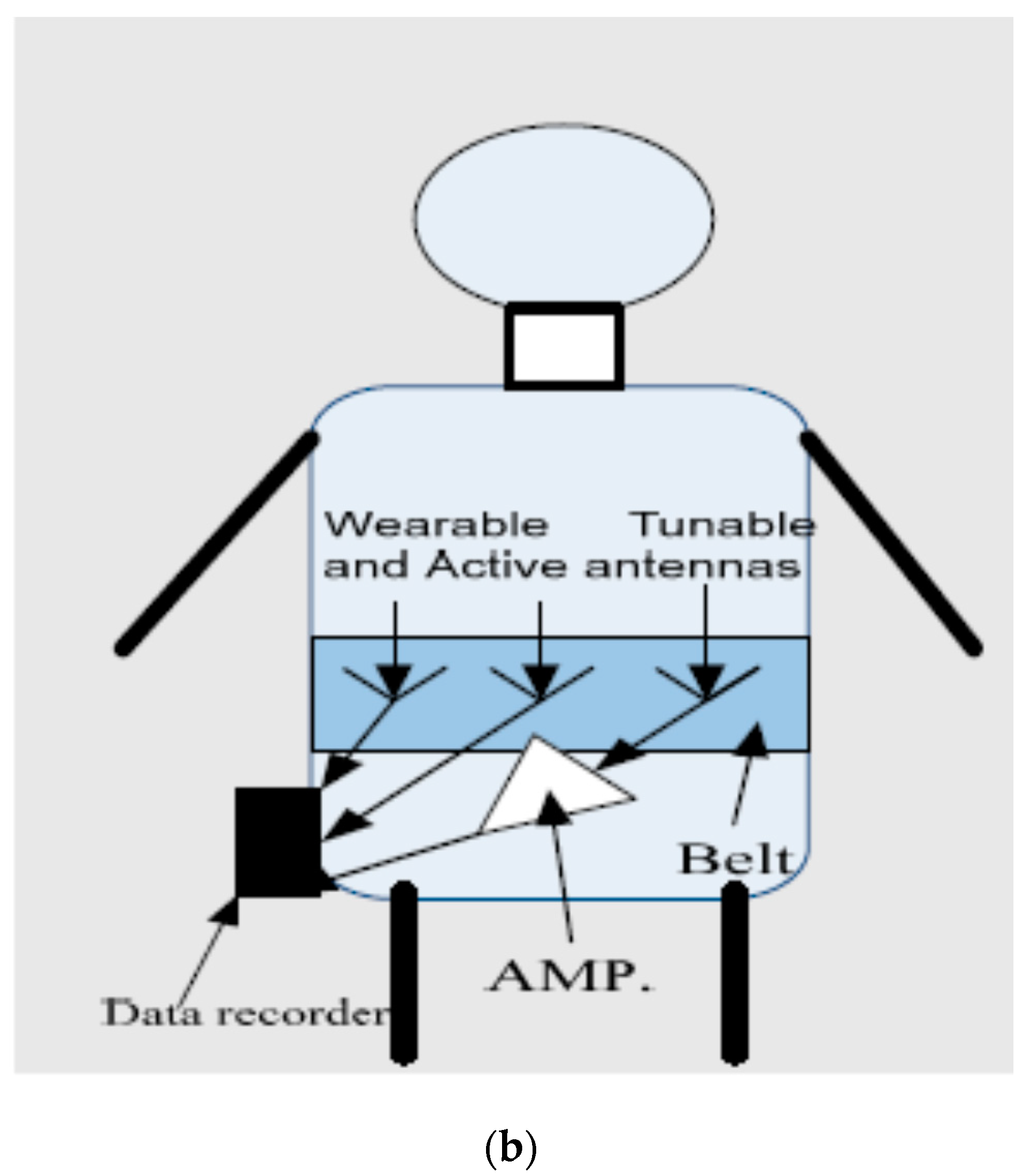
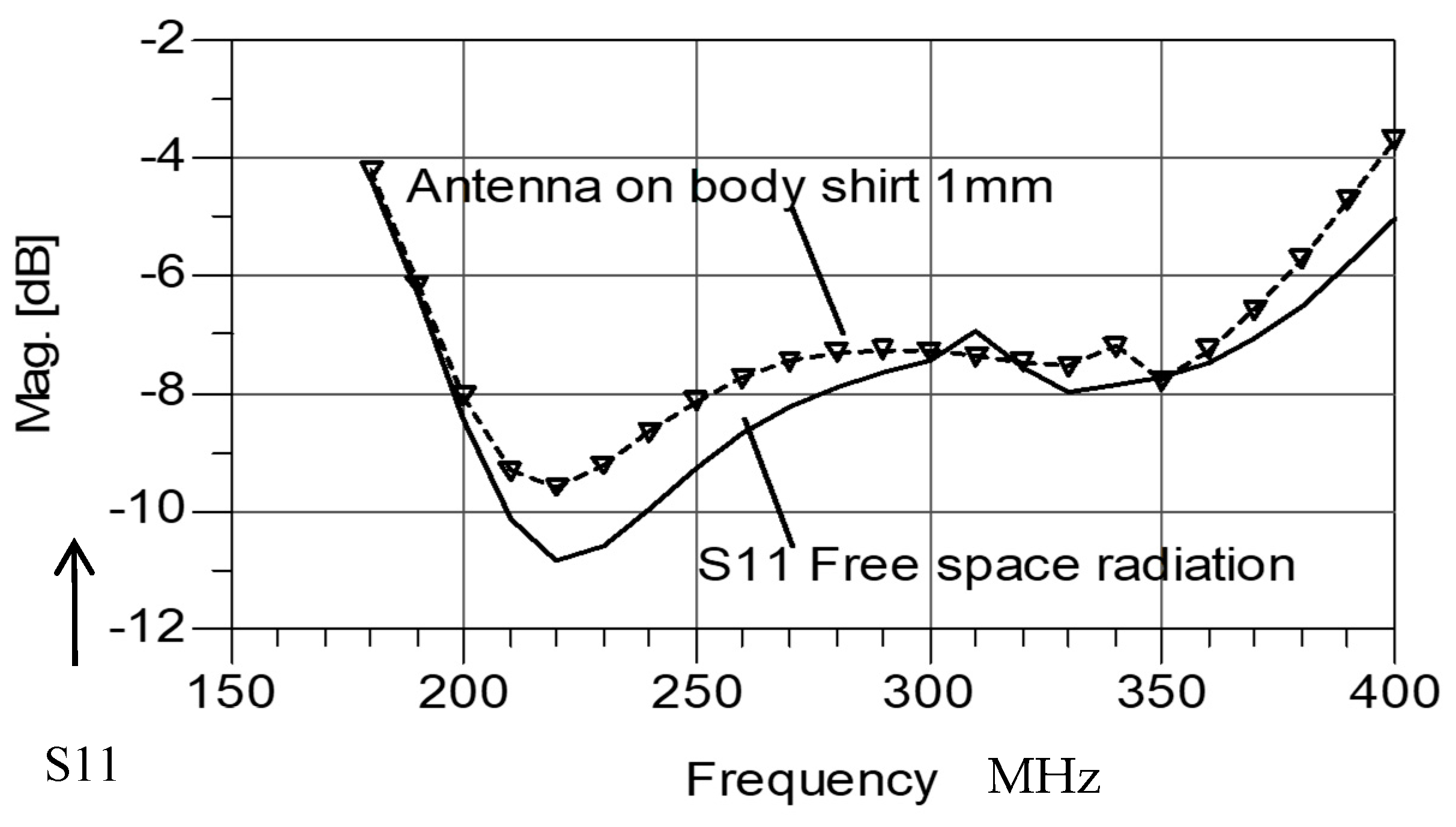
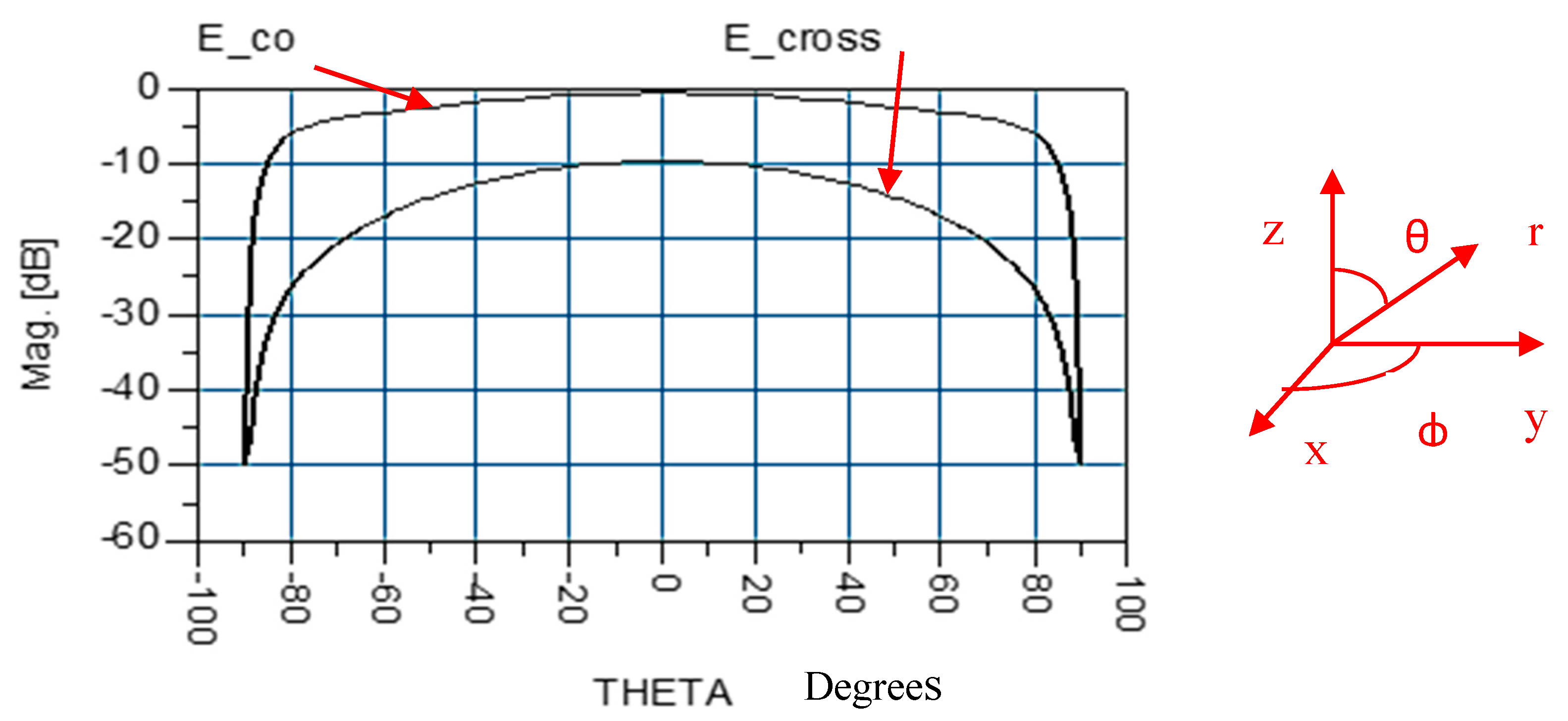
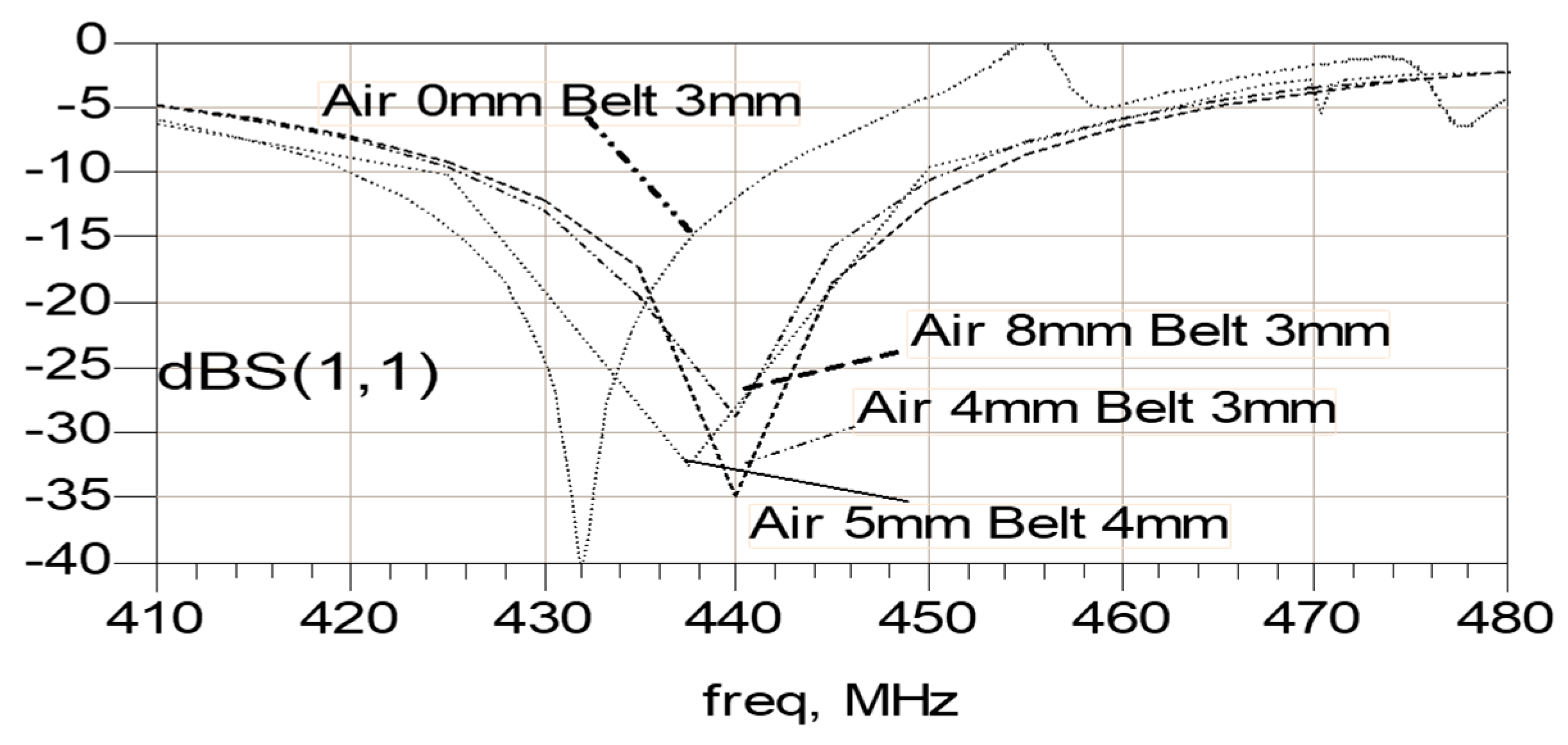
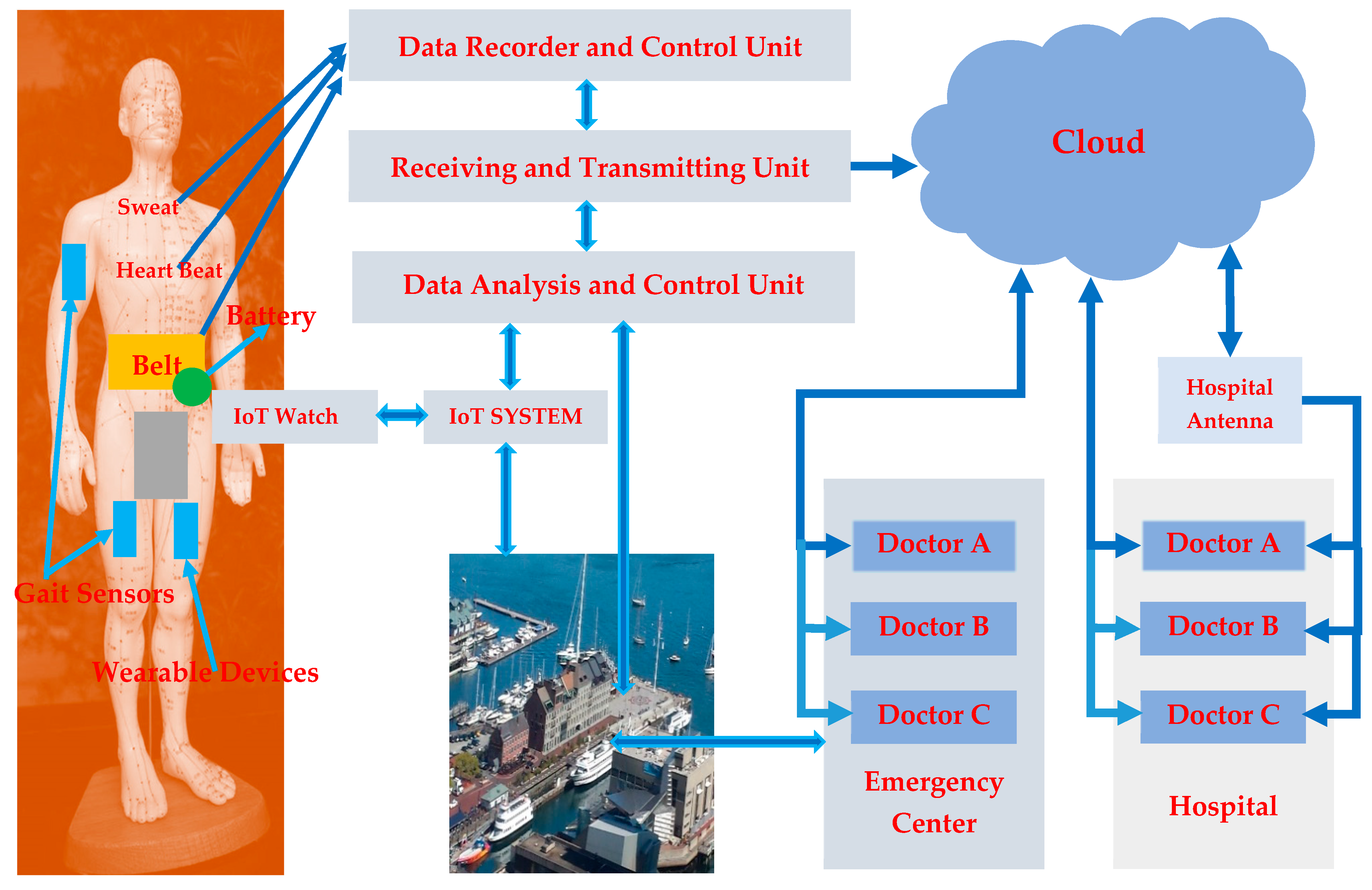
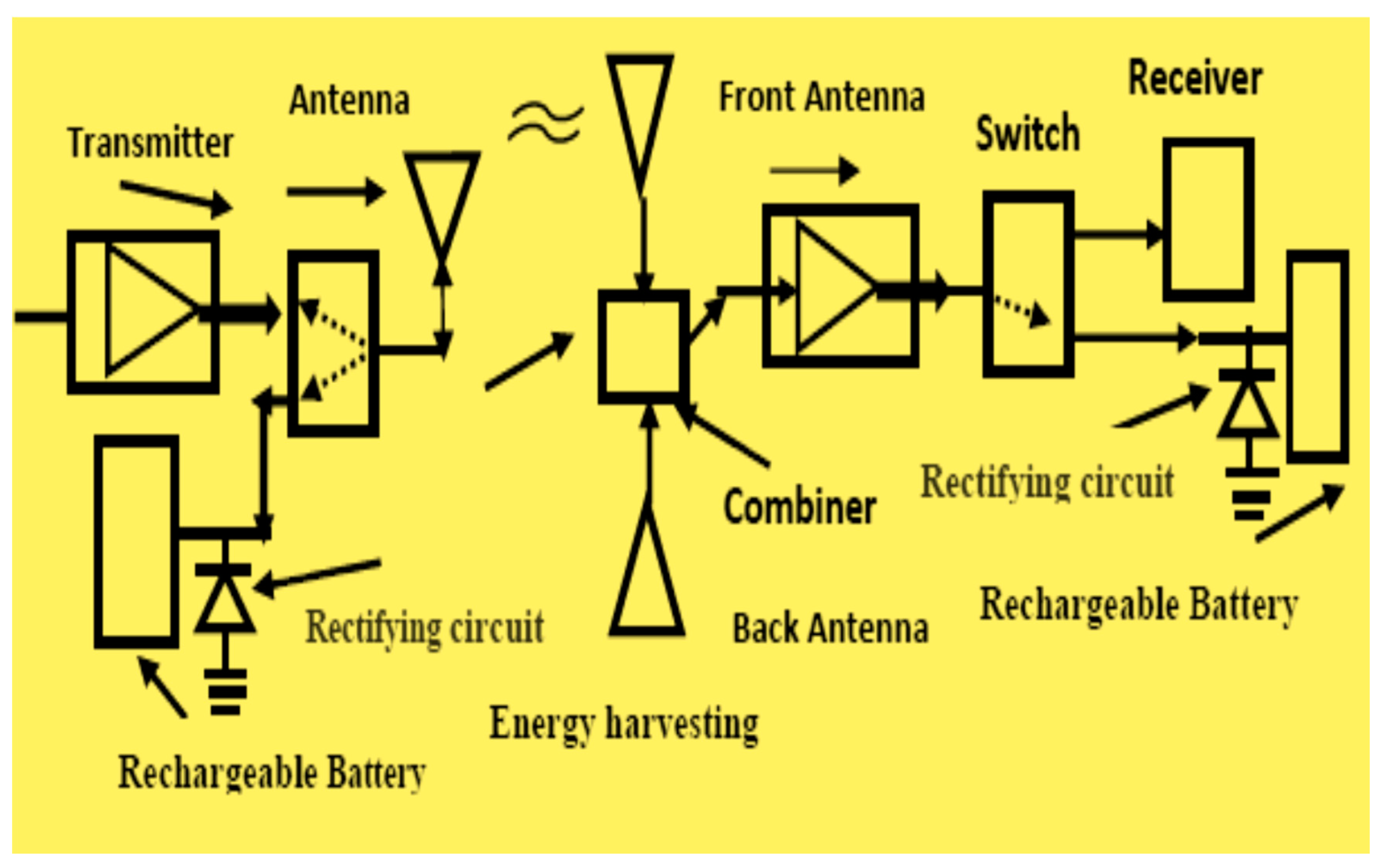
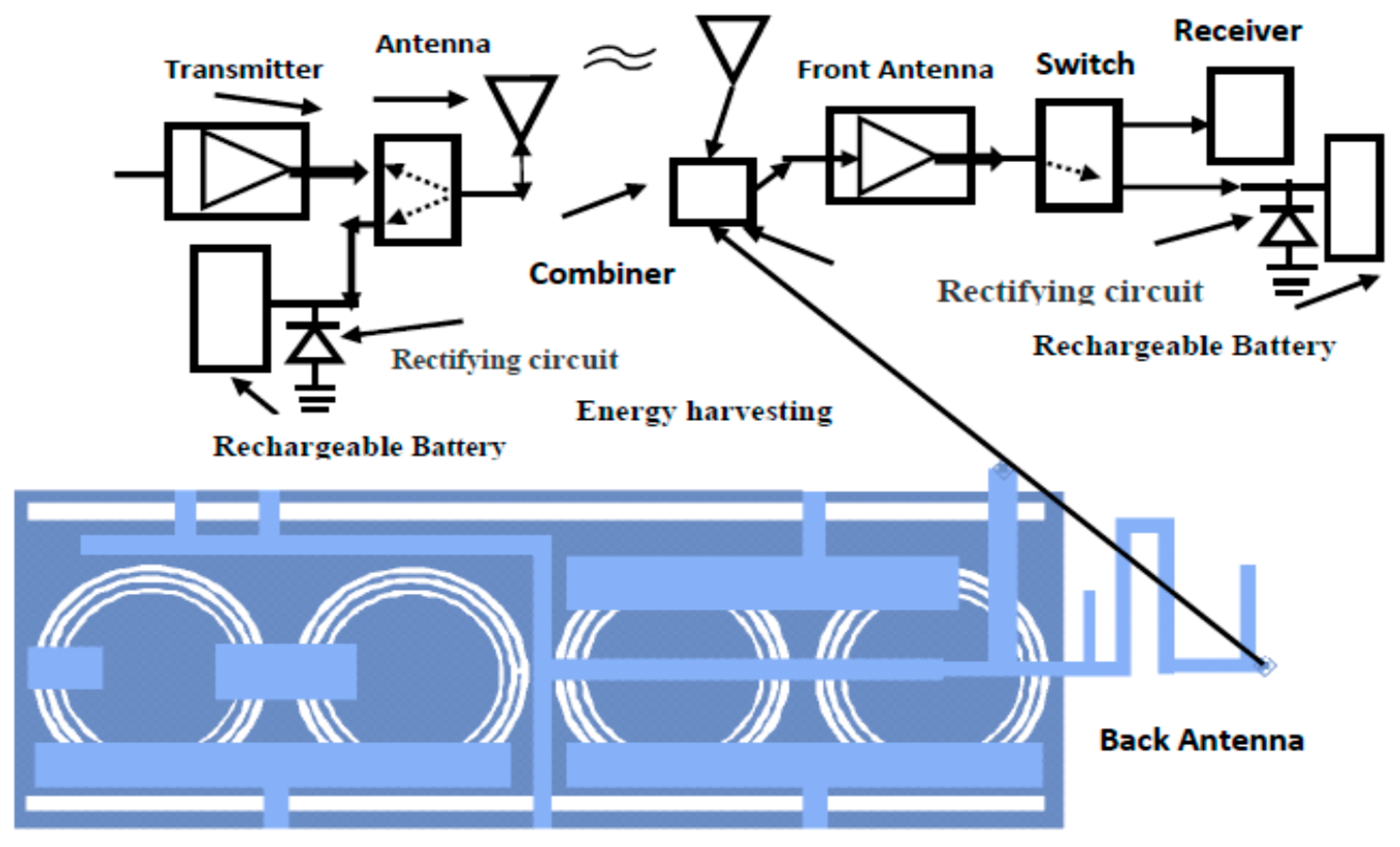
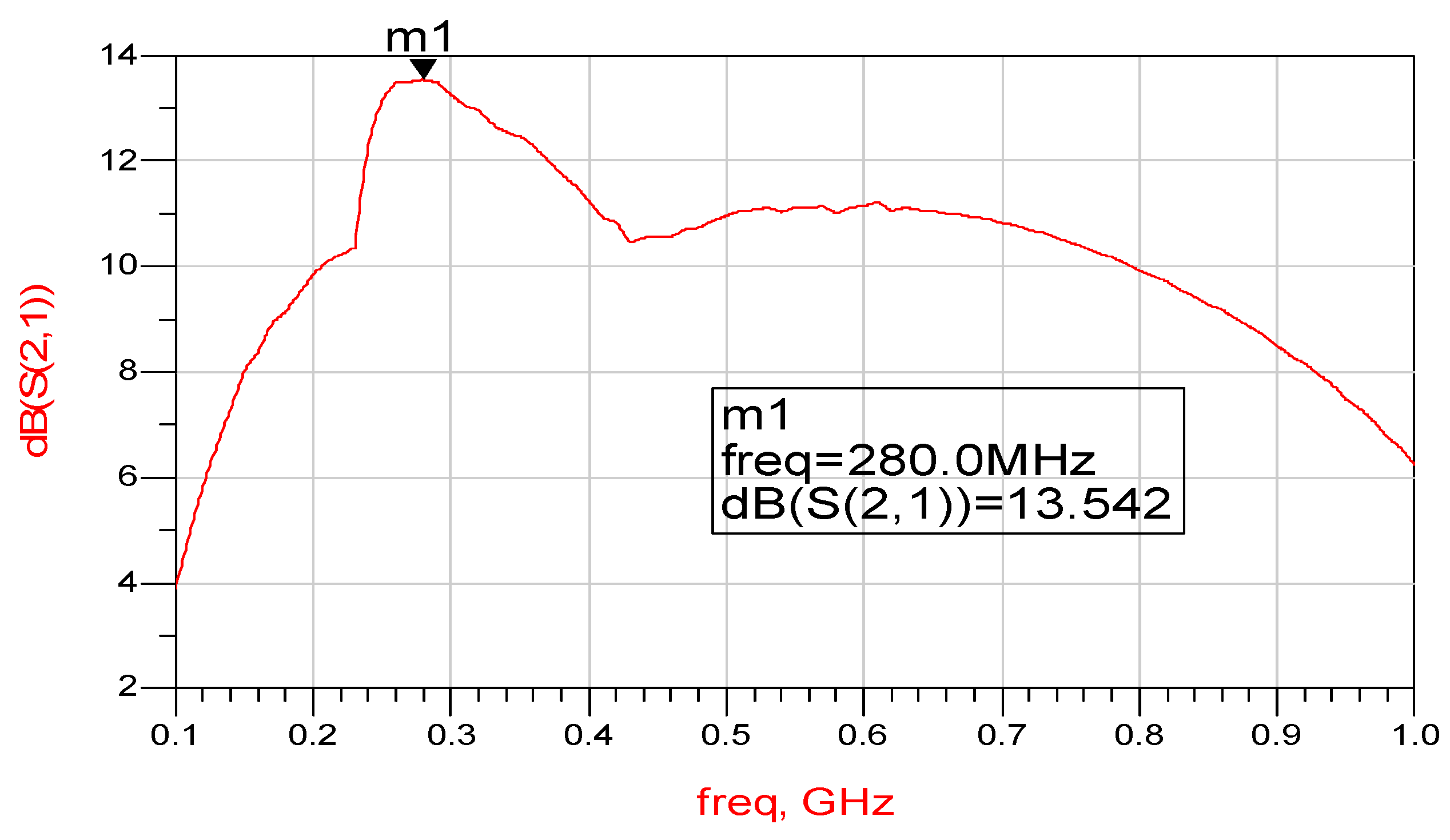
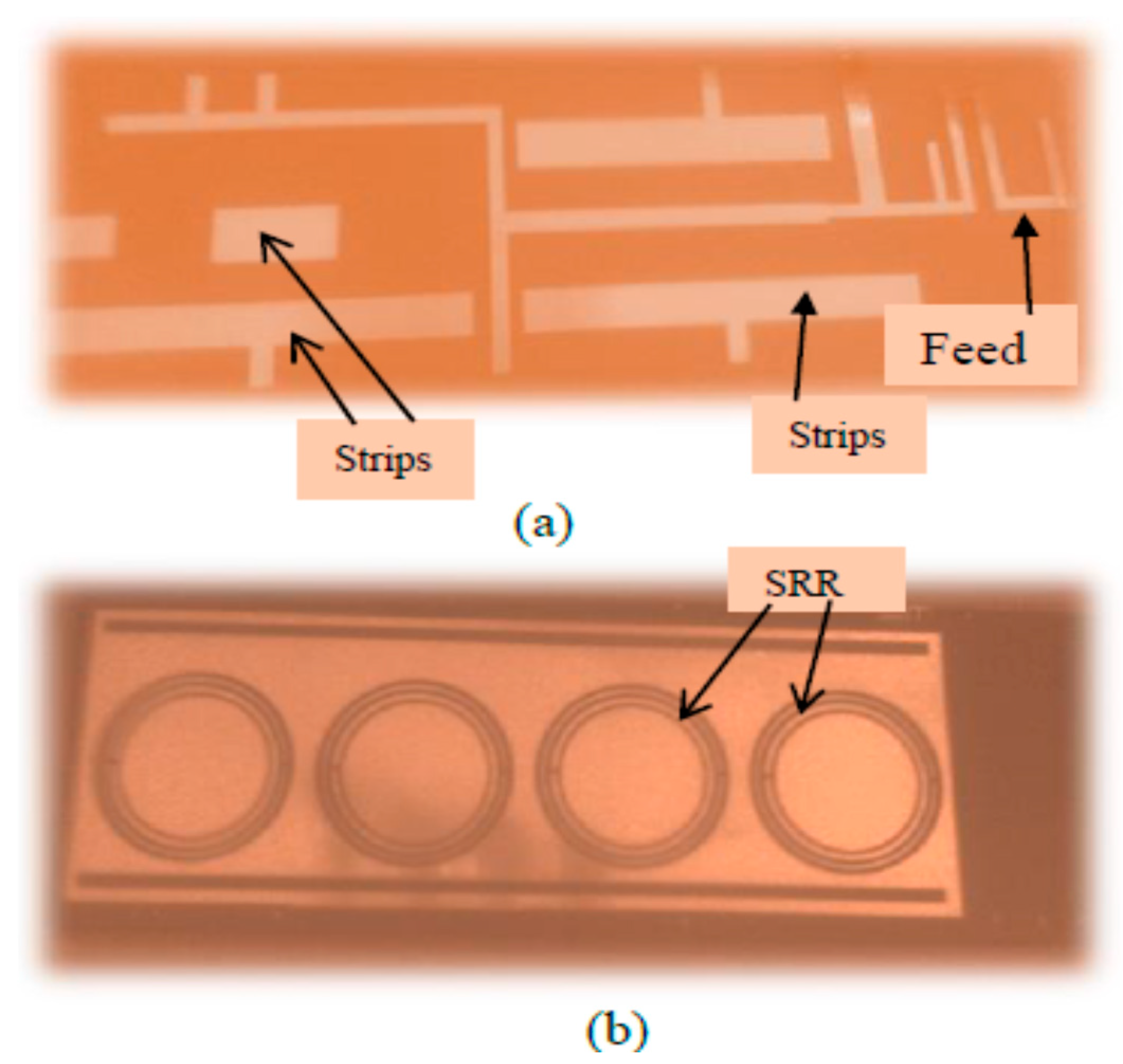
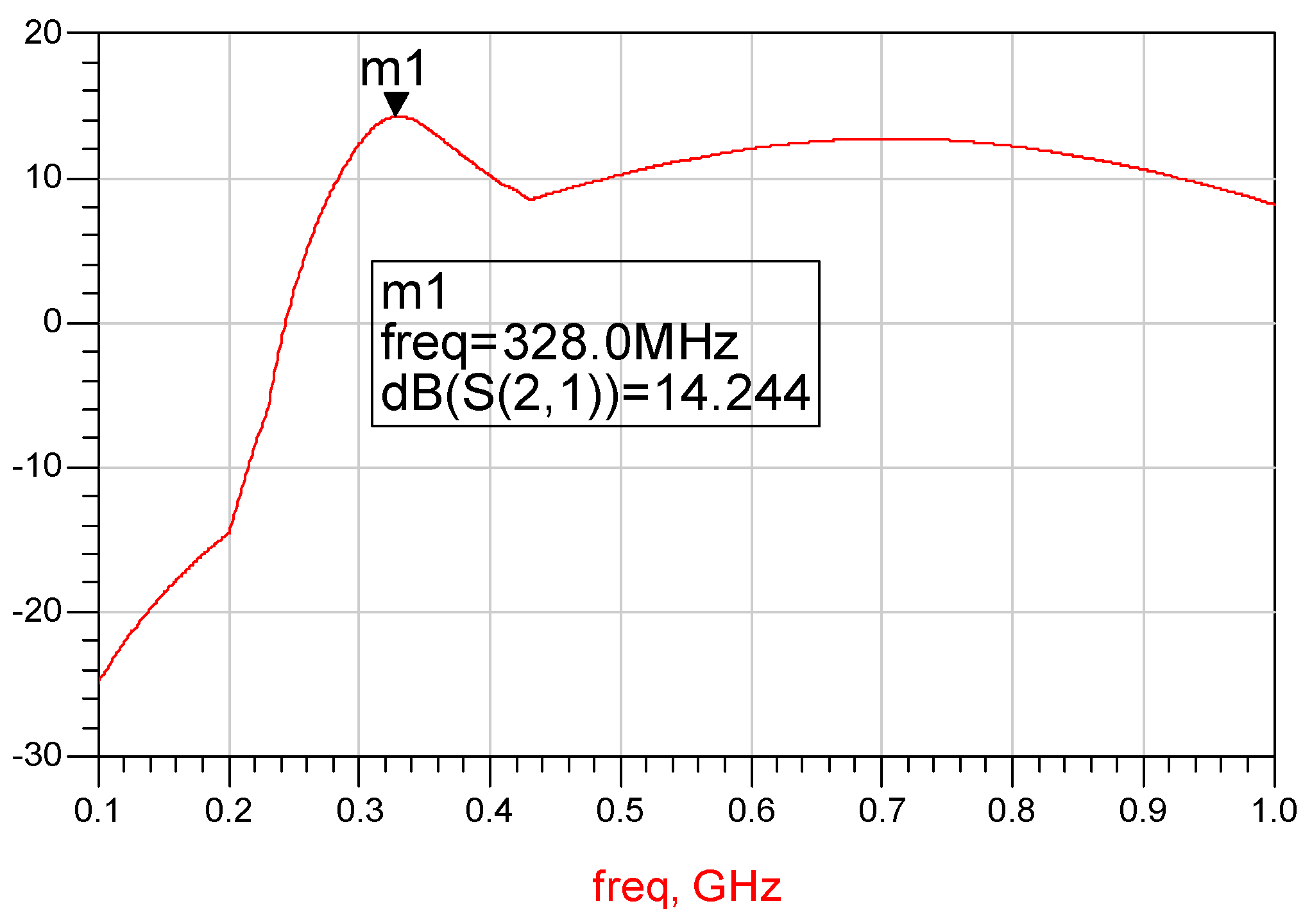
| Energy Source | Type | Efficiency | Harvested Energy |
|---|---|---|---|
| Light | Free space | 11~25% | 100 mW/cm2 |
| Heat energy | Mankind Industrial | ~0.12% ~3.2% | 60 µW/cm2 1–10 mW/cm2 |
| Vibration energy | ~Hz–Mankind ~kHz–machines | 20~52% | ~5 µW/cm3 ~810 µW/cm3 |
| RF energy | 0.9–2.7GHz—Indoor | ~50% | 0.1 µW/cm2 |
| RF energy | 0.9–2.7GHz—At malls | ~50% | 1 mW/cm2 |
| Antenna | Frequency. (MHz) | VSWR % | Gain (dBi) | Length (cm) |
|---|---|---|---|---|
| With SRR | 350 | 10 | 5.5 | 19.8 |
| Without SRR | 400 | 10 | 2.5 | 21 |
| SRR and Strips | 300 | 50 | 5.5 | 19.8 |
| Tissue | Property | 435 MHz | 605 MHz | 995 MHz |
|---|---|---|---|---|
| Human fat | σ ε | 0.045 5.00 | 0.05 5 | 0.06 4.50 |
| Human stomach | σ ε | 0.67 42.9 | 0.75 41.40 | 0.97 39.05 |
| Patient Colon | σ ε | 1.00 63.6 | 1.05 61.9 | 1.30 60.00 |
| Skin | σ ε | 0.57 41.6 | 0.6 40.45 | 0.63 40.25 |
| Human lung | σ ε | 0.27 38.4 | 0.27 38.4 | 0.27 38.4 |
| Human kidney | σ ε | 0.90 117.45 | 0.90 117.45 | 0.90 117.45 |
| Antenna | Bandwidth % | VSWR | Gain dBi |
|---|---|---|---|
| Printed dipole | 5–10 | 2:1 | 2–3 |
| Dipole with SRR | 8–12 | 2:1 | 5–7 |
| SRR and strips | 50 | 2.5:1 | 5–7.5 |
| Loop | 5–10 | 4:1 | 0 |
| Patch | 1–3 | 2:1 | 2–3 |
| Stacked Patch | 10–15 | 2:1 | 4–5 |
| Slot | 50 | 2:1 | 3 |
| T shape slot | 60 | 2:1 | 3 |
| Active slot | 40 | 3:1 | 12–20 |
| Active T slot | 50 | 3:1 | 12–20 |
| Active with SRR | 50 | 2.5:1 | 10–16 |
| Input Power dBm | Efficiency % | Remarks |
|---|---|---|
| −5 | 10 | Low Efficiency |
| −3 | 30 | Low Efficiency |
| 0 | 50 | Good Efficiency |
| 3 | 55 | Good Efficiency |
| 5 | 50 | Good Efficiency |
| 7 | 55 | Good Efficiency |
| 10 | 60 | Best Efficiency |
© 2019 by the author. Licensee MDPI, Basel, Switzerland. This article is an open access article distributed under the terms and conditions of the Creative Commons Attribution (CC BY) license (http://creativecommons.org/licenses/by/4.0/).
Share and Cite
Sabban, A. Compact Wearable Meta Materials Antennas for Energy Harvesting Systems, Medical and IOT Systems. Electronics 2019, 8, 1340. https://doi.org/10.3390/electronics8111340
Sabban A. Compact Wearable Meta Materials Antennas for Energy Harvesting Systems, Medical and IOT Systems. Electronics. 2019; 8(11):1340. https://doi.org/10.3390/electronics8111340
Chicago/Turabian StyleSabban, Albert. 2019. "Compact Wearable Meta Materials Antennas for Energy Harvesting Systems, Medical and IOT Systems" Electronics 8, no. 11: 1340. https://doi.org/10.3390/electronics8111340
APA StyleSabban, A. (2019). Compact Wearable Meta Materials Antennas for Energy Harvesting Systems, Medical and IOT Systems. Electronics, 8(11), 1340. https://doi.org/10.3390/electronics8111340




